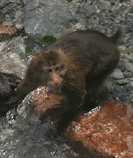Get
To Know
|
 The
Tibetan Macaque is found in mixed subtropical forests at altitudes
from 800 to 2,500 m above sea level from eastern Tibet east to Guangdong
and north to Shaanxi in China. this largest species of macaque is
one of the largest monkeys found in Asia. Males are the larger sex,
commonly attain a weight of 13 to 19.5 kg while females weigh 9
to 13 kg. Their long, dense fur is brown on the back with creamy-buff
to grey coloration on the underparts. Some adults are quite dark
brown on the back while others are basically a sandy yellowish brown
color. They have a prominent, pale-buff beard and long whiskers,
but have a hairless face. The infants have silver and black fur
that changes to its adult color at the age of two. They live in
mixed sex groups and have a complex social system; females remain
for life in their natal group, but males disperse shortly after
their adolescence (at about 8 years old). Alpha males dominate the
group, being those that are typically large, strong and newly mature.
As they age, males tend to gradually lose their social standing
and are frequently subject to challenges for dominance from other
males. Females first breed at around five years of age. The gestation
period is six months with a single offspring being produced at each
pregnancy. Males of the group may also be involved in alloparenting
care. They spend most of their time on the ground, where they forage
for leaves, fruit, grass and, to a lesser extent, flowers, seeds,
roots and insects. When available, bamboo shoots, fruits and leaves
are particularly favoured. Their main threats are all human-related.
They are sensitive to habitat destruction, as they are tied closely
to the forest. As well, they are occasionally poisoned by herbicides
and pesticides while eating and may catch diseases transmitted from
human. Illegal poaching may occur, with humans killing them for
their flesh and fur. The
Tibetan Macaque is found in mixed subtropical forests at altitudes
from 800 to 2,500 m above sea level from eastern Tibet east to Guangdong
and north to Shaanxi in China. this largest species of macaque is
one of the largest monkeys found in Asia. Males are the larger sex,
commonly attain a weight of 13 to 19.5 kg while females weigh 9
to 13 kg. Their long, dense fur is brown on the back with creamy-buff
to grey coloration on the underparts. Some adults are quite dark
brown on the back while others are basically a sandy yellowish brown
color. They have a prominent, pale-buff beard and long whiskers,
but have a hairless face. The infants have silver and black fur
that changes to its adult color at the age of two. They live in
mixed sex groups and have a complex social system; females remain
for life in their natal group, but males disperse shortly after
their adolescence (at about 8 years old). Alpha males dominate the
group, being those that are typically large, strong and newly mature.
As they age, males tend to gradually lose their social standing
and are frequently subject to challenges for dominance from other
males. Females first breed at around five years of age. The gestation
period is six months with a single offspring being produced at each
pregnancy. Males of the group may also be involved in alloparenting
care. They spend most of their time on the ground, where they forage
for leaves, fruit, grass and, to a lesser extent, flowers, seeds,
roots and insects. When available, bamboo shoots, fruits and leaves
are particularly favoured. Their main threats are all human-related.
They are sensitive to habitat destruction, as they are tied closely
to the forest. As well, they are occasionally poisoned by herbicides
and pesticides while eating and may catch diseases transmitted from
human. Illegal poaching may occur, with humans killing them for
their flesh and fur.
|
|
|
|
I Am a Yo-Yo
by
Christopher Davis
I am a human yo-yo
Yanked here and there by a snare
Around my neck.
I am yanked forward through a dark
School to prison pipeline
Shoved intentionally, roughly through.
The rope gets another hard pull
Through to my job
If I survive being hanged up in front of the prison.
My rope thrown over a tree
Again, I'm hoisted up
Away from the tree of opportunity
Its fruit teases as
Other people opposite color of me climb it like a monkey
Eating of the fruit
As I starve
Throwing rotten bits at me
Hurling recycled opportunities at my head
And every so often
One lands at my feet.
I pick one up and shove it in my breast pocket
And save it near my heart
Hoping the opportunity won't spoil
That it is something I can feed to a family of followers being
dragged behind;
I hope it will feed an entire generation of brothers and sisters
Who depend on our collective hope for survival.
While being dragged behind;
Struggling all the way.
Eventually the burning of flesh
From the friction, the tired muscles
From holding on to the rope
Cause hypertension, HIV, diabetes or some other disease
Making me tired enough
To let them make me swing from trees.
Christopher Davis is a poet, teacher, and photographer. He holds a
BA. In English and in Pan African Studies; M.A in Education; and an
Ed.S in Education. He has written thousands of poems about life. He
is the author of book of poetry entitled Only, If: Volume 1
available for download at the Apple iBook store.
|
 The
Tibetan Macaque - Issue Twenty-Three
The
Tibetan Macaque - Issue Twenty-Three